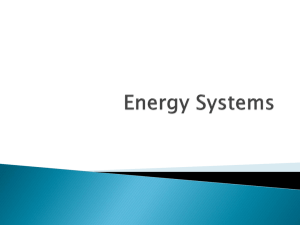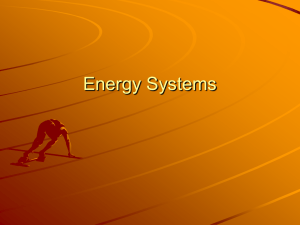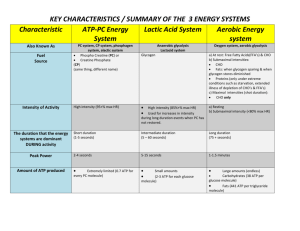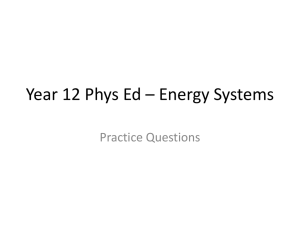Exam Prep 2
advertisement
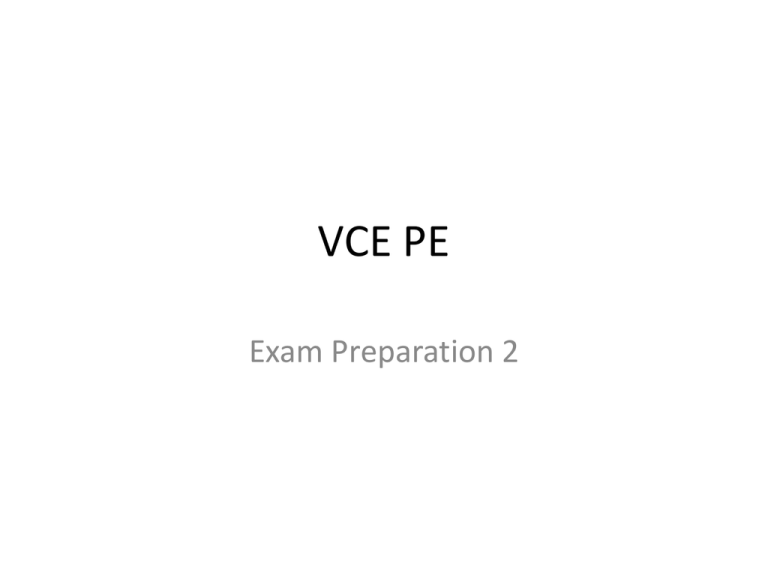
VCE PE Exam Preparation 2 Food To Energy Food Fuels for Energy 1. 2. 3. Carbohydrates (CHO) – Preferred source of fuel during exercise (Glycogen) Fat – Concentrated fuel used during rest and prolonged submaximal exercise. Protein – Used for growth and repair (Negligible use during exercise) VCE Physical Education - Unit 3 p.87 VCE Physical Education - Unit 3 Vitamins and Minerals Vitamins assist: Point 3 • Red Blood Cell Production • Tissue Repair • Protein Synthesis Minerals: Iron: Absorbed in the blood and assists in the production of haemoglobin Calcium: Major component of bones and teeth. Plays a part of muscle contraction and nerve transmission Sports Nutrition Pre Event Meal (point 10-11) • 1-4 hours prior to event • Low GI foods (sustain energy) • Low Fat and Protein: Ease digestion and avoid stomach upset. Post Event Meal Restore Muscle glycogen as quickly as possible. High GI foods (1g per 1kg of body weight within 30min of event). Can take 24hours to fully restore glycogen following event. Test Yourself • Answer Multiple Choice Questions 1-9 • 1 C, 2 A, 3 D, 4 C, 5 A, 6 B, 7 A, 8 D, 9 C Energy Systems ATP-PC System Characteristic ATP-PC energy System Also known as PC System, CP system, phosphagen system, alactic system Fuel Source Phospho Creatine (PC) or Creatine Phosphate: same thing Intensity of Activity High 95+ % max Heart rate Duration of system being dominant in activity Short (1-5 sec) Peak power 2-4 Sec ATP amount produced Small : 0.7 ATP each PC molecule Speed ATP produced Explosive: relies on simple chemical reactions By-products Inorganic Phosphates (Pi) ADP and AMP Lactic Acid System Characteristic Lactic Acid System Also known as Anaerobic glycolysis, Lactacid system Fuel Source Glycogen Intensity of Activity High: 85+% of max HR Duration of system being dominant in activity Intermediate duration 5-60 sec Peak power 5-15 sec ATP amount produced Small 2-3 ATP each glucose molecule Speed ATP produced Fast: Longer chemical reactions than ATP system By-products Lactic Acid, H+ ions, ADP Aerobic System Characteristic Aerobic System Also known as Oxygen System, aerobic glycolysis Fuel Source Rest: FFA’s and CHO Sub max activities: CHO, Fats when CHO diminished, Protein: Extreme condition Intensity of Activity Rest Sub Max activity: under 80% HR max Duration of system being dominant in activity Long duration: 75 + sec Peak power 1-1.5 min ATP amount produced Lots (endless) CHO (38 ATP per glucose molecule) Fats (441 ATP per triglyceride molecule Speed ATP produced Medium: Complex chemical reactions. Fats slower to resynthesise ATP than fats By-products CO2, H2O Heat Common Mistake • The three energy systems do not turn on and off like a traffic light. • They are always interactive– the relative contribution of each system varies depending on factors such as intensity, type of activity and duration. VCE Physical Education - Unit 3 Interplay Between Energy Systems All activities use some energy from all three systems. The energy systems overlap – they never work independently. It it’s the relative contribution of each system that varies. VCE Physical Education - Unit 3 Anaerobic v Aerobic Contributions VCE Physical Education - Unit 3 Key Points • Accumulation of Hydrogen Ions: Hydrogen Ions are a By-Product of the Lactic Acid System (anaerobic glcolysis). H+ cause the muscle pH to drop (become more acidic). This inhibits the glycolytic enzymes and makes contractions difficult. Maximal Oxygen Uptake • The maximum amount of oxygen per minute that can be transported to, taken up and used by the body for energy production. Measured as mL/kg x min Male Female Active young men 50.8 Active young women 45.4 AFL players 53.9 National Hockey 50.1 National Volleyball 56.4 National Volleyball 46.8 National Middle Dist 67 National Middle Dist 62.1 Long Dist 73.5 Test Yourself • Answer Short Answer Question Answer a/ ATP-PC System b/ 50% c/ You can work at a percentage greater than 100% VO2 Max by working anaerobically. d/ The test Percentage is different because it is not at maximal intensity, unlike a 400m race. Complete Multiple choice Questions • Question 1-9 Answers 1 B, 2 D, 3A, 4 C, 5 C, 6 B, 7 A, 8A, 9C Fatigue and Recovery • Fatigue occurs when the body is unable to function at it’s optimum level. Energy levels are depleted. Causes of Fatigue Anaerobic Exercise Aerobic Exercise Fuel Depletion, ATP-PC, Creatine Phosphate Fuel Depletion: Glycogen Metabolic By-Product Accumulation Hydrogen Ions, Inorganic Phosphate and ADP Increase Body Temp Dehydration Effects of Fatigue • Increased Body Temp: Blood is directed away from the working muscles for cooling. Results in reduced blood and oxygen to the working muscle. • Dehydration: Can result in impaired performance (Blood flow away from working muscles). Blood plasma volumes decrease. To maintain Q, HR must increase. RECOVERY • Active Recovery (cool down): Low intensity exercise to continue movement of blood from working muscles (avoid blood pooling). • Passive Recovery: Best to replenish PC stores as more o2 available to replenish. • Lactic Acid Breakdown: 50% removal in 30min (halved with active recovery) 95% removal in 30min with an active recovery Test Yourself • Answer Multiple Choice 1-8 • Answers 1 D, 2 A, 3A, 4C, 5C, 6D, 7A, 8B Short Answer Ques 9 a/ The athlete is restoring Muscle glycogen b/ This should be eaten in the first 30 minute following a race. c/ To promote muscle repair and growth d/ Best fuel source is High GI Carbs as the provide a fuel source that can be used immediately.

